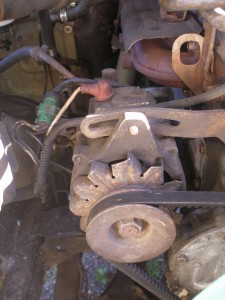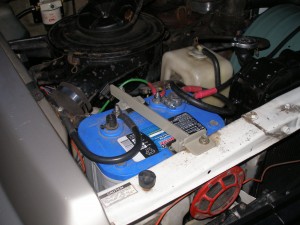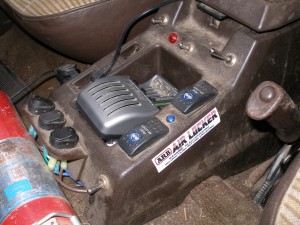By Tony K (with a little bit of help from Steve K)
I will be the first to admit this is the area I lack the most knowledge in. But I am learning more all the time and figured we needed a place for basic electrical what not.
 -The Alternator and the Batteries-
-The Alternator and the Batteries-
An important point to remember is that the main purpose of the alternator is to power the electrical load of your rig, the lights, heater, stereo, wipers, etc. as well as recharge the battery. The rated output of your alternator was chosen by the load the manufacturer designed into our rigs. Typically it is rated at 125% of the maximum load the rig would require. This way it can run the system as well as have something left over to recharge the batteries.
The batteries reason to exist is to supply the power needed by your rig. Primarily starting the rig but they also provide power when the load exceeds the charge capability, for example idling or short trips that don’t allow the alternator enough time or amps to recharge the batteries. They also serve as the source of power when the charge system fails. Something that happened to me shortly after I got my diesel running. Fortunately my diesel doesn’t have a lot of draw on the electrical system so the 15 or so times I started the rig that day didn’t have much effect on the charge of the batteries. But having dual deep cycle batteries probably played a major role in my rig not dying.
Both parts of this system need to be functioning properly to get the best from them. Clean corrosion free connections and good solid grounds are essential.
Look what happens with a dead battery, you may be able to jump start the rig but the lights may not work well until the alternator has a chance to recharge the battery. It’s doing double duty trying to bring the battery back to life while at the same time light up your world. Give your alternator a break and let it have some time to bring the battery back up before you put a load on the system. Good strong batteries can make this happen faster.
And your batteries just may be more important than the output of your alternator. It could be that dual batteries provide a better solution to a short term high amp draw than a high output alternator. Batteries serve somewhat as a cushion whenever you put a large load on the system. Consider my winch, it is capable of drawing 360 Amps but there is no way I would put that big of an alternator in the rig, instead the batteries supply the power while it’s being used and the alternator recharges things when it shuts down. Would this work with a constant load that exceeded the alternators capacity? No, because you would eventually draw down the batteries below a usable voltage.
-Cold Crank Amps or CCA-
We have all seen this number but what does it mean? This is the definition I found “CCA is the discharge load in Amps that a new fully charged battery at 0 degrees F can deliver for 30 seconds while maintaining voltage above 7.2V”. The higher the number the better it will crank the engnine over. An added bonus of running two batteries wired in parallel is that it will double the available CCA.
-RC, which is short for Reserve Capacity-
This number is also listed on your battery and here is what that number stands for ‘Number of minutes, a fully charged battery at 80 degrees F can be discharged at a constant 25A until the voltage falls below 10.5 volts” Basically it shows how much endurance your battery has, how long its going to take for the battery to die should you leave the headlights on. It also helps compensate for loads created from stop and go driving.
-Battery 101-
There are tons of different types of batteries but the ones of most interest to us as wheelers are start and deep cycle batteries.
Start batteries are designed to do just that, handle the quick heavy Amp loads required to turn over an engine. They also do this while not discharging a large amount, what is called the Depth of Discharge. Typically no more than 10% for a start battery.
Deep cycle batteries on the other hand are meant to be discharged anywhere from 20 to 80% of their rated capacity (depth of discharge again) with no ill effects. But this is done at a much lower amp draw than a start battery.
And just what is the difference between start and deep cycle? Without going into a technical dissertation of how these two types of batteries function, and in as few words as possible, it all comes down to the surface area of the internal plates. Start batteries have thin plates, which results in lots of surface area per cell. Which means lots of amperage potential. But being so thin they are suspect to dissolution during long discharge periods. As for deep cycle batteries, thick plates, less surface area, lower instant amps availability, but can handle long slow discharge periods. Lastly, a good starter and good cabling generally doesn’t require the total number of amps designed into the start batteries so this means a deep cycle, such as Optimas, can be used to start your rig.
And this brings up a little, but important thing called cycles. Batteries are designed with only so many cycles in their service life. One cycle is one time to it’s depth of discharge and one time recharging. A start battery has only so many start cycles in it. And just like a start batttery, a deep cycle is also made with an intended number of cycles.
Since a start battery is not intended to be deeply discharged, doing so will shorten it’s life dramatically. Deep cycle batteries on the other hand are meant to constantly be discharged and recharged. And for reasons I don’t quite fathom a deep cycle battery is not nearly effected being used as a start battery. But there will be some shortening of its life as starting brings about a much higher amp draw quickly, something the deep cycle was not originally intended to do. But as long as it meets the OEM standards and has the CCA to start your rig it’s OK to run deep cycle batteries for your start battery
 -Spiral wound AGM batteries-
-Spiral wound AGM batteries-
Better known as Optima’s. Like all things today technology is changing batteries. What was valid yesterday may not be so today. I have been running dual Blue Top Marine Optima’s for several years in both my wagons. These batteries are considered dual purpose, both a start and deep cycle battery in one. Model is the D34M, it has 750 CCA and an RC of 120 minutes. But since I run two of them it actually has close to 1500 CCA and 240 minutes of reserve capacity.
Why you should run a spiral wound AGM in your rig
-15 times the vibration resistance of a wet lead acid battery
-Two times the number of cycles
-Smaller, with the same capacity
-They can be recharged faster without damage
-Withstands heat better, which is the major killer of batteries
-Can be mounted in any orientation and won’t spill fluid if you roll your rig
 –Accessories–
–Accessories–
Just what can I run in my rig? All depends on the amp draw whether your electrical system will sustain it. Extras may exceed the alternators capacity and this requires the batteries to make up for the power not supplied by the charge system. And like I mentioned already, I did find out what will happen if you exceed the systems rated output capacity, while things may run just fine for a prolonged period eventually you will discharge the batteries to the point that they will not start your rig. So paying attention to the load on the system is a good idea if you have a lot of electronics turned on. At some point you may need to turn a bunch of them off just to let the charge system build up the voltage.
You can find out what the amp draw is of all your accessories by some simple math. The formula is Watts = Volts x Amps. Or Watts/Volts =Amps All you need to know is two of these and the other one comes out in the math. Ideally the combined load of all accessories should be less than 75% of the charge system output. This leaves the rest to recharge the batteries.
–In Conclusion–
I am a bit less confused than I used to be but electrical issues still leave me with a sore brain. But if you really want to overload on battery and charge system know how go here: http://www.batteryfaq.org/ This site definately helped with some of the gaps in my knowledge of the charge system.

